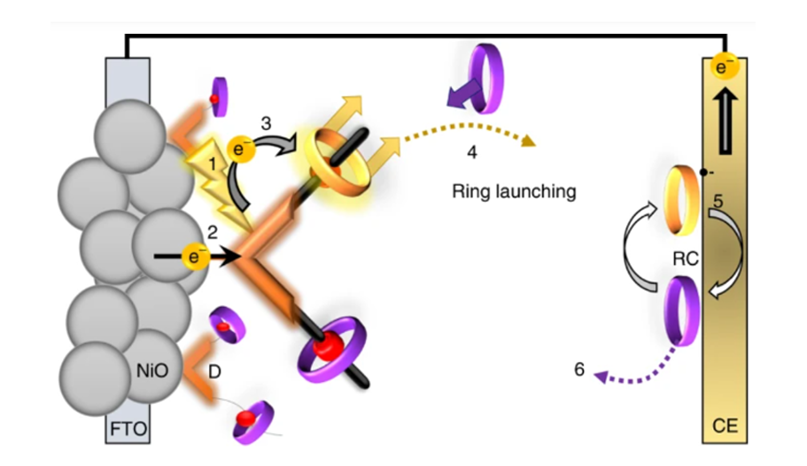Using supramolecular machinery to engineer directional charge propagation in photoelectrochemical devices

31 October 2022
Photoelectrochemical devices are promising for solar energy conversion. However, a higher efficiency of the photocathode, often based on functionalized NiO, is needed. The work just published in Nature Chemistry with our collaborators Dr. Tessel Bouwens, Prof. Joost Reek and colleagues of the University of Amsterdam presents a novel strategy for directional charge propagation in photoelectrochemical devices. We show how pseudorotaxane motifs can be used as molecular machinery to reduce charge recombination and enhance the efficiency.
Molecular photoelectrochemical devices are hampered by electron–hole recombination after photoinduced electron transfer, causing losses in power conversion efficiency. Inspired by natural photosynthesis, we demonstrate the use of supramolecular machinery as a strategy to inhibit recombination through an organization of molecular components that enables unbinding of the final electron acceptor upon reduction. We show that preorganization of a macrocyclic electron acceptor to a dye yields a pseudorotaxane that undergoes a fast (completed within ~50 ps) ‘ring-launching’ event upon electron transfer from the dye to the macrocycle, releasing the anionic macrocycle and thus reducing charge recombination. Implementing this system into p-type dye-sensitized solar cells yielded a 16-fold and 5-fold increase in power conversion efficiency compared to devices based on the two control dyes that are unable to facilitate pseudorotaxane formation. The active repulsion of the anionic macrocycle with concomitant reformation of a neutral pseudorotaxane complex circumvents recombination at both the semiconductor–electrolyte and semiconductor–dye interfaces, enabling a threefold enhancement in hole lifetime.
About the research
The complexes have been designed and characterized by Dr. Tessel Bouwens, former PhD student in the group of Prof. Joost Reek at the University of Amsterdam. The ultrafast photochemical processes following photoexcitation and the ‘ring-launching’ event have been analyzed by femtosecond transient absorption studies by Kaijian Zhu and Dr. Annemarie Huijser.
Publication details
T. Bouwens, T. M. A. Bakker, K. Zhu, J. Hasenack, M. Dieperink, A. M. Brouwer, A. Huijser, S. Mathew, J. N. H. Reek: A Bioinspired Strategy for Directional Charge Propagation in Photoelectrochemical Devices Using Supramolecular Machinery, Nat. Chem. (2022). DOI: 10.1038/s41557-022-01068-y





